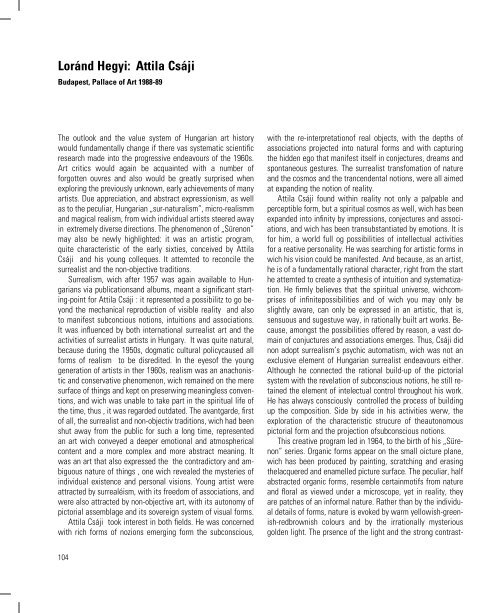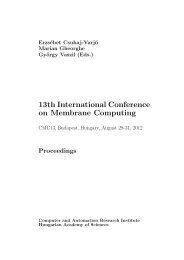Time on the Tilt
Time on the Tilt
Time on the Tilt
You also want an ePaper? Increase the reach of your titles
YUMPU automatically turns print PDFs into web optimized ePapers that Google loves.
Loránd Hegyi: Attila Csáji<br />
Budapest, Pallace of Art 1988-89<br />
The outlook and <strong>the</strong> value system of Hungarian art history<br />
would fundamentally change if <strong>the</strong>re vas systematic scientific<br />
research made into <strong>the</strong> progressive endeavours of <strong>the</strong> 1960s.<br />
Art critics would again be acquainted with a number of<br />
forgotten ouvres and also would be greatly surprised when<br />
exploring <strong>the</strong> previously unknown, early achievements of many<br />
artists. Due appreciati<strong>on</strong>, and abstract expressi<strong>on</strong>ism, as well<br />
as to <strong>the</strong> peculiar, Hungarian „sur-naturalism”, micro-realismm<br />
and magical realism, from wich individual artists steered away<br />
in extremely diverse directi<strong>on</strong>s. The phenomen<strong>on</strong> of „Süren<strong>on</strong>”<br />
may also be newly highlighted: it was an artistic program,<br />
quite characteristic of <strong>the</strong> early sixties, c<strong>on</strong>ceived by Attila<br />
Csáji and his young colleques. It attemted to rec<strong>on</strong>cile <strong>the</strong><br />
surrealist and <strong>the</strong> n<strong>on</strong>-objective traditi<strong>on</strong>s.<br />
Surrealism, wich after 1957 was again available to Hungarians<br />
via publicati<strong>on</strong>sand albums, meant a significant starting-point<br />
for Attila Csáji : it represented a possibilitz to go bey<strong>on</strong>d<br />
<strong>the</strong> mechanical reproducti<strong>on</strong> of visible reality and also<br />
to manifest subc<strong>on</strong>cious noti<strong>on</strong>s, intuiti<strong>on</strong>s and associati<strong>on</strong>s.<br />
It was influenced by both internati<strong>on</strong>al surrealist art and <strong>the</strong><br />
activities of surrealist artists in Hungary. It was quite natural,<br />
because during <strong>the</strong> 1950s, dogmatic cultural policycaused all<br />
forms of realism to be disredited. In <strong>the</strong> eyesof <strong>the</strong> young<br />
generati<strong>on</strong> of artists in <strong>the</strong>r 1960s, realism was an anach<strong>on</strong>istic<br />
and c<strong>on</strong>servative phenomen<strong>on</strong>, wich remained <strong>on</strong> <strong>the</strong> mere<br />
surface of things and kept <strong>on</strong> preserwing meaningless c<strong>on</strong>venti<strong>on</strong>s,<br />
and wich was unable to take part in <strong>the</strong> spiritual life of<br />
<strong>the</strong> time, thus , it was regarded outdated. The avantgarde, first<br />
of all, <strong>the</strong> surrealist and n<strong>on</strong>-objectiv traditi<strong>on</strong>s, wich had been<br />
shut away from <strong>the</strong> public for such a l<strong>on</strong>g time, represented<br />
an art wich c<strong>on</strong>veyed a deeper emoti<strong>on</strong>al and atmospherical<br />
c<strong>on</strong>tent and a more complex and more abstract meaning. It<br />
was an art that also expressed <strong>the</strong> <strong>the</strong> c<strong>on</strong>tradictory and ambiguous<br />
nature of things , <strong>on</strong>e wich revealed <strong>the</strong> mysteries of<br />
individual existence and pers<strong>on</strong>al visi<strong>on</strong>s. Young artist were<br />
attracted by surrealéism, with its freedom of associati<strong>on</strong>s, and<br />
were also attracted by n<strong>on</strong>-objective art, with its aut<strong>on</strong>omy of<br />
pictorial assemblage and its sovereign system of visual forms.<br />
Attila Csáji took interest in both fields. He was c<strong>on</strong>cerned<br />
with rich forms of nozi<strong>on</strong>s emerging form <strong>the</strong> subc<strong>on</strong>scious,<br />
with <strong>the</strong> re-interpretati<strong>on</strong>of real objects, with <strong>the</strong> depths of<br />
associati<strong>on</strong>s projected into natural forms and with capturing<br />
<strong>the</strong> hidden ego that manifest itself in c<strong>on</strong>jectures, dreams and<br />
sp<strong>on</strong>taneous gestures. The surrealist transfomati<strong>on</strong> of nature<br />
and <strong>the</strong> cosmos and <strong>the</strong> trancendental noti<strong>on</strong>s, were all aimed<br />
at expanding <strong>the</strong> noti<strong>on</strong> of reality.<br />
Attila Csáji found within reality not <strong>on</strong>ly a palpable and<br />
perceptible form, but a spiritual cosmos as well, wich has been<br />
expanded into infinity by impressi<strong>on</strong>s, c<strong>on</strong>jectures and associati<strong>on</strong>s,<br />
and wich has been transubstantiated by emoti<strong>on</strong>s. It is<br />
for him, a world full og possibilities of intellectual activities<br />
for a reative pers<strong>on</strong>ality. He was searching for artistic forms in<br />
wich his visi<strong>on</strong> could be manifested. And because, as an artist,<br />
he is of a fundamentally rati<strong>on</strong>al character, right from <strong>the</strong> start<br />
he attemted to create a syn<strong>the</strong>sis of intuiti<strong>on</strong> and systematizati<strong>on</strong>.<br />
He firmly believes that <strong>the</strong> spiritual universe, wichcomprises<br />
of infinitepossibilities and of wich you may <strong>on</strong>ly be<br />
slightly aware, can <strong>on</strong>ly be expressed in an artistic, that is,<br />
sensuous and sugestuve way, in rati<strong>on</strong>ally built art works. Because,<br />
am<strong>on</strong>gst <strong>the</strong> possibilities offered by reas<strong>on</strong>, a vast domain<br />
of c<strong>on</strong>juctures and associati<strong>on</strong>s emerges. Thus, Csáji did<br />
n<strong>on</strong> adopt surrealism’s psychic automatism, wich was not an<br />
exclusive element of Hungarian surrealist endeavours ei<strong>the</strong>r.<br />
Although he c<strong>on</strong>nected <strong>the</strong> rati<strong>on</strong>al build-up of <strong>the</strong> pictorial<br />
system with <strong>the</strong> revelati<strong>on</strong> of subc<strong>on</strong>scious noti<strong>on</strong>s, he still retained<br />
<strong>the</strong> element of intelectual c<strong>on</strong>trol throughout his work.<br />
He has always c<strong>on</strong>sciously c<strong>on</strong>trolled <strong>the</strong> process of building<br />
up <strong>the</strong> compositi<strong>on</strong>. Side by side in his activities werw, <strong>the</strong><br />
explorati<strong>on</strong> of <strong>the</strong> characteristic strucure of <strong>the</strong>aut<strong>on</strong>omous<br />
pictorial form and <strong>the</strong> projecti<strong>on</strong> ofsubc<strong>on</strong>scious noti<strong>on</strong>s.<br />
This creative program led in 1964, to <strong>the</strong> birth of his „Süren<strong>on</strong>”<br />
series. Organic forms appear <strong>on</strong> <strong>the</strong> small oicture plane,<br />
wich has been produced by painting, scratching and erasing<br />
<strong>the</strong>lacquered and enamelled picture surface. The peculiar, half<br />
abstracted organic forms, resemble certainmotifs from nature<br />
and floral as viewed under a microscope, yet in reality, <strong>the</strong>y<br />
are patches of an informal nature. Ra<strong>the</strong>r than by <strong>the</strong> individual<br />
details of forms, nature is evoked by warm yellowish-greenish-redbrownish<br />
colours and by <strong>the</strong> irrati<strong>on</strong>ally mysterious<br />
golden light. The prsence of <strong>the</strong> light and <strong>the</strong> str<strong>on</strong>g c<strong>on</strong>trast-<br />
“Couple II.”, 1966<br />
104 105
















